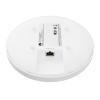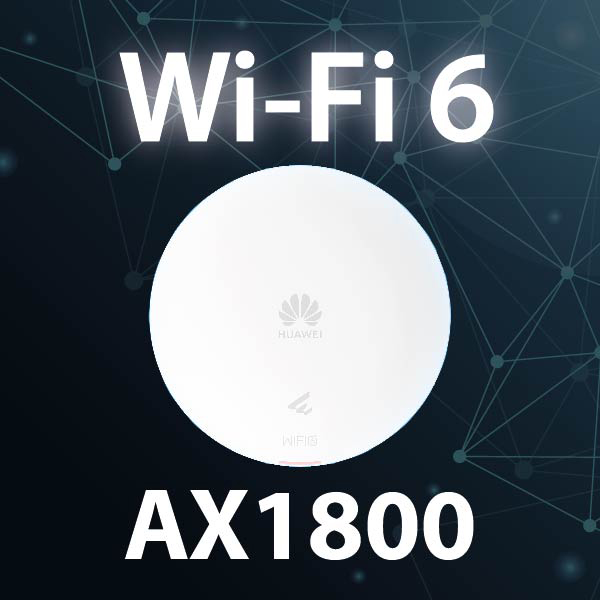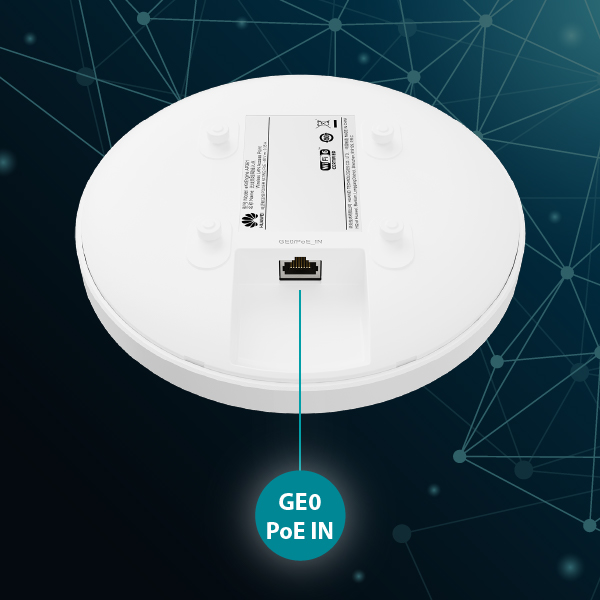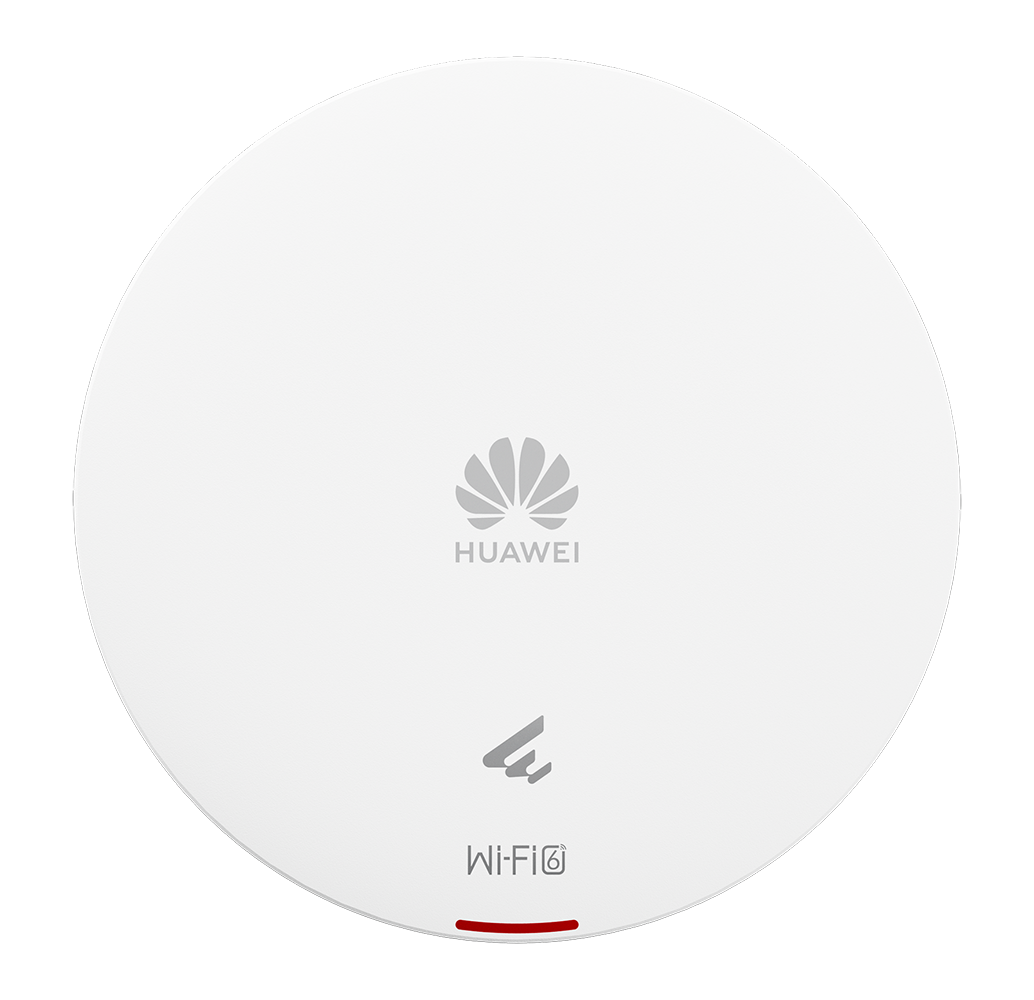-
€








The Huawei AP361 is an access point from the eKitEngine series that supports the Wi-Fi 6 standard. It supports IEEE protocols b/g/n/ax in the 2.4 GHz band and IEEE 802.11 a/n/ac/ax in the 5 GHz band. The maximum theoretical throughput is 574 Mb/s in 2.4 GHz and 1201 Mb/s in 5 GHz. The device supports MU-MIMO (simultaneous transmission and reception of data from multiple users) and BSS coloring (marking transmissions to reduce interference). The access point features a Smart antenna, constructed with multiple elements capable of independent operation. Depending on the needs, the antenna elements can modify the shape of the main beam and adapt to connected clients. The AP361 enclosure is designed for wall, ceiling, or T-rail mounting. The device has one gigabit Ethernet port (10/100/1000 Mb/s), which also serves as the input for IEEE 802.3 af PoE power.
The offered product can operate in several modes: Fat AP, Fit AP, or Cloud. In Fat AP mode, the device functions independently, allowing you to configure it like a regular wireless router. Cloud mode enables connecting the device to a controller located in the cloud, while Fit AP mode is used to connect to another physical WLAN AC controller. Solutions from the eKitEngine series enable you to create extensive and efficient wireless networks that can cover very large areas. The devices support data roaming, band steering, and various authentication methods. They are ideal for a wide range of applications, from home use to large companies and restaurants.
Wi-Fi 6 AX1800 wireless network
The AP361 is designed to transmit Wi-Fi 6 wireless networks, supporting IEEE 802.11 b/g/n/ax protocols in the 2.4 GHz band and IEEE 802.11 a/n/ac/ax protocols in the 5 GHz band. The maximum theoretical throughput is 574 Mb/s in 2.4 GHz and 1201 Mb/s in 5 GHz. This speed is more than sufficient for most internet-related activities, including streaming 4K videos online, gaming, or downloading large files.
The access point also utilizes several additional features that positively impact network quality. MU-MIMO allows simultaneous transmission and reception of data from multiple clients, eliminating data queuing. Beamforming is used to shape the beam to improve connections with devices at the edge of the coverage area.


Gigabit Ethernet port, Power over Ethernet
The offered product is equipped with a 1-gigabit Ethernet port (10/100/1000 Mb/s), which also serves as the input for IEEE 802.3 af PoE power, supporting the standard. The maximum power consumption is only 8.8 W.
Smart antennas
The access point features Smart antennas, constructed with multiple elements that can operate independently. Depending on the requirements, the antenna elements can modify the shape of the main beam to provide the best coverage to connected clients. The device adapts to radio conditions and provides significantly better signal coverage than APs equipped with standard omni-directional antennas. The gain is 4 dBi in the 2.4 GHz band and 5 dBi in the 5 GHz band.


Up to 128 clients
The Huawei AP361 can support up to 128 client devices connected simultaneously. APs from the eKitEngine series are well-suited for locations with, or potentially with, many users. This access point supports essential functions such as band steering and setting priority for the 5 GHz band (5G-prior). Client devices are primarily connected in the 5 GHz band to ensure optimal throughput, reducing congestion and interference in the 2.4 GHz band.
Advanced wireless system
The offered product is designed to operate in a large wireless system composed of multiple access points. Such a network is capable of covering even very large areas, depending on the number of devices used. The system supports data roaming, allowing users to seamlessly switch between individual access points without losing their connection.
Huawei solutions offer a wide range of features related to bandwidth control, transmission quality improvement, and security. For user authentication, you can utilize methods such as 802.1x, MAC address, or captive portal. An advanced management and monitoring system will allow you to reduce the time spent on network administration, for example, through automatic detection and recognition of errors.


Three operating modes
Access points can operate in four modes:
- Fat AP - the access point operates independently, and configuration and management are similar to standard wireless routers. It's suitable for small networks where you only use one AP.
- Cloud AP - in this mode, the access point can be managed from a cloud-based platform. This platform significantly facilitates monitoring and initial configuration, eliminating the need for additional management devices.
- Fit AP - this is the basic mode of operation in which the access point connects to a controller.
Multiple uses
The Huawei AP361 is suitable as a basic access point in networks where AX1800 throughput is sufficient. It can be used in locations with a stable number of users, such as homes or office spaces. However, for installations in conference rooms and other areas where there may be occasional significant increases in users, it's better to use high-density access points, such as the A362 model. The AP361 stands out for its very good price-to-quality ratio. With a relatively low cost, you can create an extensive wireless network using Wi-Fi 6 and many modern features.

Specifications
| Huawei AP361 | |
| Technical specifications | |
|---|---|
| Dimensions (diameter x length) | Φ180 mm x 35 mm |
| Weight | 0,45 kg |
| Port type |
1 x 10M/100M/1GE electrical port (The GE electrical port supports PoE input) |
| LED indicator | Indicates the power-on, startup, running, alarm, and fault states of the system. |
| Power specifications | |
| Power input | PoE power supply: in compliance with IEEE 802.3af |
| Maximum power consumption | 8,8 W |
| Environmental specifications | |
| Operating temperature | –10°C to +50°C |
| Storage temperature | –40°C to +70°C |
| Operating humidity | 5% to 95% (non-condensing) |
| Radio specifications | |
| Antenna type | Built-in smart antennas |
| Antenna gain |
2,4 GHz: 4 dBi 5 GHz: 5 dBi |
| Maximum quantity of SSIDs on each radio |
≤ 6 |
| Device capacity | ≤ 128 |
| Maximum transmit power |
2,4 GHz: 20 dBm 5 GHz: 20 dBm (The actual transmit power depends on local laws and regulations) |
| Power adjustment increment | 1 dBm |
| Maximum number of nonoverlapping channels |
2.4 GHz (2.412 GHz - 2.472 GHz) 802.11 b/g
802.11 n
802.11 ax
5 GHz (5.18 GHz - 5.825 GHz) 802.11 a
802.11 n
802.11 ac
802.11 ax
(The number of non-overlapping channels varies with countries) |
| Fat/Fit AP mode | |
| WLAN features | Compliance with IEEE 802.11ax and compatibility with IEEE 802.11a/b/g/n/ac/ac Wave 2 Maximum ratio combining (MRC) Space time block code (STBC) Cyclic delay diversity (CDD)/Cyclic shift diversity (CSD) Beamforming Multi-user multiple-input multiple-output (MU-MIMO) Orthogonal frequency division multiple access (OFDMA) Compliance with 1024-QAM and compatibility with 256-QAM, 64-QAM, 16-QAM, 8-QAM, quadrature phase shift keying (QPSK), and binary phase shift keying (BPSK) Low-density parity-check (LDPC) Frame aggregation, including A-MPDU (Tx/Rx) and A-MSDU (Tx/Rx) 802.11 dynamic frequency selection (DFS) Short guard interval (GI) in 20 MHz, 40 MHz, and 80 MHz modes Wi-Fi multimedia (WMM) for priority-based data processing and forwarding WLAN channel management and channel rate adjustment Automatic channel scanning and interference avoidance Separate service set identifier (SSID) hiding configuration for each AP, supporting Chinese SSIDs Signal sustain technology (SST) Unscheduled automatic power save delivery (U-APSD) Control and Provisioning of Wireless Access Points (CAPWAP) in Fit AP mode Extended service set (ESS) in Fit AP mode Advanced cellular coexistence (ACC), minimizing the impact of interference from cellular networks Multi-user call admission control (CAC) 802.11k and 802.11v smart roaming 802.11r fast roaming (≤ 50 ms) |
| Network features | Compliance with IEEE 802.3ab Auto-negotiation of the rate and duplex mode and automatic switchover between the Media Dependent Interface (MDI) and Media Dependent Interface Crossover (MDI-X) Compliance with IEEE 802.1Q SSID-based VLAN assignment VLAN trunk on uplink Ethernet ports Management channel of the AP's uplink port in tagged or untagged mode DHCP client, obtaining IP addresses through DHCP Tunnel data forwarding and direct data forwarding STA isolation in the same VLAN IPv4/IPv6 access control list (ACL) Link layer discovery protocol (LLDP) Uninterrupted service forwarding upon CAPWAP tunnel disconnection in Fit AP mode Unified authentication on the WAC in Fit AP mode WAC dual-link backup in Fit AP mode Network address translation (NAT) in Fat AP mode IPv6 in Fit AP mode IPv6 Source Address Validation Improvement (SAVI) Multicast Domain Name Service (mDNS) gateway protocol |
| QoS features | WMM parameter management for each radio WMM power saving Priority mapping for upstream packets and flow-based mapping for downstream packets Queue mapping and scheduling User-based bandwidth limiting Adaptive bandwidth management (automatic bandwidth adjustment based on the user quantity and radio environment) for user experience improvement Airtime scheduling Air interface HQoS scheduling Intelligent multimedia scheduling algorithm |
| Security features | Unified management and maintenance on the WAC in Fit AP mode Automatic login, automatic configuration loading, and plug-and-play (PnP) in Fit AP mode Automatic batch upgrade in Fit AP mode Telnet STelnet using SSHv2 SFTP using SSHv2 Web system-based AP management and login through HTTP or HTTPS in Fat AP mode Real-time configuration monitoring and fast fault locating using the NMS SNMP v1/v2/v3 in Fat AP mode System status alarm Network Time Protocol (NTP) in Fat AP mode |
| Maintenance features |
Zunifikowane monitorowanie i zarz?dzanie w kontrolerze, w trybie Fit AP Automatyczne logowanie, wczytywanie konfiguracji (plug&play) w trybie Fit AP Grupowa aktualizacja w trybie Fit AP Telnet STelnet z wykorzystaniem SSHv2 SFTP z wykorzystaniem SSHv2 Zarz?dzanie Web poprzez HTTP/HTTPS w trybie Fat AP Monitorowanie "na ?ywo", szybkie wykrywanie b??dów poprzez NMS SNMP v1/v2/v3 w trybie Fat AP System status alarm NTP (Network Time Protocol) w trybie Fat AP |
| Location services |
Wi-Fi terminal location (The AP supports the location service only in Fit AP mode) |
| Tryb Cloud | |
| WLAN features | Compliance with IEEE 802.11a/b/g/n/ac/ac Wave 2/ax Maximum ratio combining (MRC) Space time block code (STBC) Cyclic delay diversity (CDD)/Cyclic shift diversity (CSD) Beamforming Multi-user multiple-input multiple-output (MU-MIMO) Orthogonal frequency division multiple access (OFDMA) Compliance with 1024-QAM and compatibility with 256-QAM, 64-QAM, 16-QAM, 8-QAM, quadrature phase shift keying (QPSK), and binary phase shift keying (BPSK) Low-density parity-check (LDPC) Frame aggregation, including A-MPDU (Tx/Rx) and A-MSDU (Tx/Rx) 802.11 dynamic frequency selection (DFS) Short guard interval (GI) in 20 MHz, 40 MHz, and 80 MHz modes Priority mapping and scheduling that are compliant with Wi-Fi multimedia (WMM) to implement priority-based data processing and forwarding WLAN channel management and channel rate adjustment. Automatic channel scanning and interference avoidance Separate service set identifier (SSID) hiding configuration for each AP Signal sustain technology (SST) Unscheduled automatic power save delivery (U-APSD) |
| Network features | Compliance with IEEE 802.3ab Auto-negotiation of the rate and duplex mode and automatic switchover between the Media Dependent Interface (MDI) and Media Dependent Interface Crossover (MDI-X) Compliance with IEEE 802.1Q SSID-based VLAN assignment DHCP client, obtaining IP addresses through DHCP STA isolation in the same VLAN Access control list (ACL) Unified authentication on the cloud management platform Network address translation (NAT) |
| QoS features | Priority mapping and scheduling that are compliant with Wi-Fi multimedia (WMM) to implement priority-based data processing and forwarding WMM parameter management for each radio WMM power saving Priority mapping for upstream packets and flow-based mapping for downstream packets Queue mapping and scheduling User-based bandwidth limiting Airtime scheduling Air interface HQoS scheduling |
| Security features | Open system authentication WEP authentication/encryption using a 64-bit, 128-bit, 152-bit or 192-bit encryption key WPA2-PSK authentication and encryption WPA2-802.1X authentication and encryption WPA3-SAE authentication and encryption WPA3-802.1X authentication and encryption WPA-WPA2 hybrid authentication WPA2-WPA3 hybrid authentication 802.1X authentication, MAC address authentication, Portal authentication, etc. DHCP snooping Dynamic ARP inspection (DAI) IP Source Guard (IPSG) |
| Maintenance features | Unified management and maintenance on the cloud management platform Automatic login, automatic configuration loading, and plug-and-play (PnP) Batch upgrade supported Telnet STelnet using SSHv2 SFTP using SSHv2 Web-based NMS management, and login through HTTP or HTTPS Real-time configuration monitoring and fast fault locating using the NMS System status alarm Network Time Protocol (NTP) |






 Polski
Polski English
English Italiano
Italiano Español
Español Čeština
Čeština Српски
Српски Deutsch
Deutsch Ελληνικά
Ελληνικά Slovenský
Slovenský




